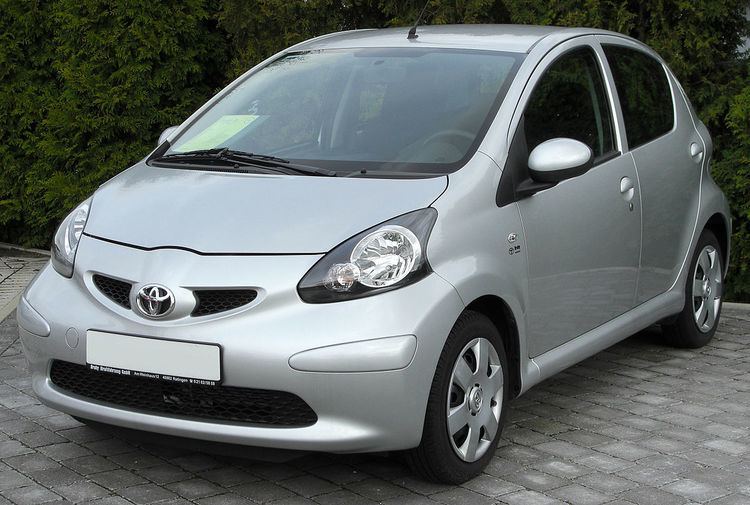Class City car | Production 2005–present | |
 | ||
The Toyota Aygo /ˈaɪɡoʊ/ is a city car sold by Toyota in Europe since 2005. All Aygos are built with the related Citroën C1 and the Peugeot 107/108 at the new factory of the Toyota Peugeot Citroën Automobile Czech (TPCA) joint venture in Kolín, Czech Republic. The Aygo was first displayed at the 2005 Salon de l'Automobile de Genève. The name "Aygo" comes from "i-go", symbolising freedom and mobility.
Contents
First generation (AB10; 2005–2014)
The decision to produce the cars was made on July 12, 2001, when the presidents of Toyota and PSA Peugeot Citroën, Fujio Cho and Jean-Martin Folz respectively, decided to produce a small car to share development costs. This project was called B-Zero. The Peugeot 107 and Citroën C1 are rebadged versions of the same car.
The Aygo's starting on-the-road price is 8,500 € (GB£6,845). The main difference between the Aygo and its siblings is in the interior equipment, badges, logos and the easily recognizable rear end of the car. The planned production is 300,000 cars annually – 100,000 cars per brand. Sales began in July 2005 and the car is available as a three or five-door hatchback. There are two engines available, a 1.0 L three-cylinder engine rated at 68 bhp (51 kW), and a 1.4 L HDi diesel I4 engine rated at 54 bhp (40 kW).
The Aygo was used on BBC's Top Gear in a giant match of football, showcasing its maneuverability. The Top Gear presenters deemed the Aygo and its Peugeot and Citroën counterparts to be competent town cars.
A modified Aygo was also used on Fifth Gear to perform a 12 metre high loop-the-loop on a specially-designed track to determine if a stunt that can be done using Hot Wheels toys can be replicated in real life. The stunt was driven by UK Stuntman Steve Truglia in May 2009.
In January 2010, the Aygo was part of a worldwide recall by Toyota for a faulty sticking accelerator pedal. It was found that under some circumstances, the pedal could stick in a partially depressed position, or return slowly to the off position. The recall affected the Aygo, Peugeot 107 and Citroën C1 models built between February 2005 and August 2009. Information from Toyota later suggested, however, that only Aygos with automatic gearboxes were affected, and that those with manual gearboxes were not.
2009–2012
The Aygo received its first facelift, replacing the front bumper shape from the original, and changing the rear lights to a transparent appearance, from their original red-tinted cluster.
2012–2014
The Aygo received its second facelift, this time incorporating a much more angular bumper, and space for the inclusion of daytime running lights (DRL).
Reliability
Breakdown statistics reported by the German Automobile Club in May 2010 placed the Aygo (which the data grouped with the Citroën C1 and Peugeot 107) at the top of the sub-small car class in respect of the low break-down rates achieved for cars aged between one and four years.
"Aygo Crazy" concept
In 2008, Toyota created a driveable one-off concept car based on the Toyota Aygo. Named the Aygo Crazy, it was unveiled to the public at the July 2008 British International Motor Show in London, before appearing at other UK-based motor shows that year.
Aygo Crazy has a mid mounted 1.8 litre VVTi engine from the Toyota MR2 and Celica, mated to an MR2 five speed gearbox and fitted with a Toyota Motorsport turbocharger conversion. The manufacturer claims the engine produces 147 kW (197 bhp) at 6,700 rpm and 240 N·m (177 lb·ft) torque at 3,400 rpm.
Weighing just 1,050 kg (2,315 lb), this gives it a 0–100 km/h (0–62 mph) sprint time of 5.75 seconds and a theoretical top speed of 204 km/h (127 mph), though the latter has not been tested. Unlike the standard Aygo, it has no driver aids, power steering or anti-lock brakes but its rear wheel drive layout helps traction under heavy acceleration.
Exterior modifications include wider arches to accommodate the one inch of extra track, 17-inch alloy wheels with Goodyear tyres and a carbon fibre rear spoiler designed for the 322 km/h (200 mph) American Champ Car series.
Suspension is from the MR2, with adjustable Tein shock absorbers and MacPherson struts front and rear. To cope with the extra power, Toyota upgraded the standard 247 mm (9.7 in) front brake discs to a 328 mm (12.9 in) Brembo conversion, with 280 mm (11.0 in) ventilated rear discs replacing the 200 mm (7.9 in) drums normally found on the Aygo. An uprated Helix clutch is also used.
The interior features a partial roll cage for extra chassis comfort and driver protection. Two specially designed sports seats, trimmed in red and black, and a suede-rimmed Sparco steering wheel complete the race-inspired look.
Toyota claims the Aygo Crazy cost GB£100,000 to build.
Second generation (AB40; 2014–present)
Toyota revealed the new-look, completely redesigned Aygo, at the March 2014 Geneva Motor Show with the slogan 'go fun yourself'. The design was attributed to Japanese youth culture, inspired by Japanese manga-robot AstroBoy, and an egg in a box and has aims to make the Aygo more accessible to younger drivers, and allow for a greater level of customisability. It rolled off the production line on May 27, 2014.
Models include:
The Aygo also includes numerous safety features such as vehicle stability control (VSC), anti-lock braking system (ABS), hill-start assist control (HAC) and supplemental restraint system (SRS) with six airbags.
